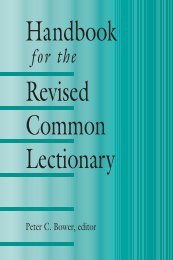000 Allen FMT (i-xxii) - The Presbyterian Leader
000 Allen FMT (i-xxii) - The Presbyterian Leader
000 Allen FMT (i-xxii) - The Presbyterian Leader
Create successful ePaper yourself
Turn your PDF publications into a flip-book with our unique Google optimized e-Paper software.
Trinity Sunday/Year A 45<br />
and unjust, and, consequently, God allowed the Babylonians to invade and<br />
conquer the nation, and take many of Israel’s leaders into exile in Babylon.<br />
To some Israelites the gods of the Babylonians appeared to be more<br />
powerful than their own God. When many of the leaders returned from<br />
Babylon, they found the infrastructure of Palestine in disarray, and the<br />
returnees often came into conflict with residents who had remained in<br />
Palestine during the exile. Israel’s life was a kind of chaos.<br />
Genesis 1:1–2:4a asserts the sovereignty of the God of Israel over all<br />
other deities. <strong>The</strong> Babylonian story of creation, Enuma Elish, told the<br />
story of creation as a fierce battle between Tiamat, ruler of the watery<br />
deep, and the god Marduk, in which the world was created when Marduk<br />
slayed Tiamat and split Tiamat’s carcass in half to form the upper and<br />
lower parts of the universe. <strong>The</strong> God of Israel, in contrast, creates by<br />
nothing more than speaking. Furthermore, Genesis implies that objects<br />
that were often deified in the ancient Near East—such as sun, moon, stars,<br />
and animals—are simply creatures. People commit idolatry by worshiping<br />
such things.<br />
<strong>The</strong> Priestly account critiques the Babylonian story by indicating in<br />
Genesis1:1–2 that before God began to create, the universe was a “deep,”<br />
the Hebrew word for which (tehom) is related to the name Tiamat. <strong>The</strong><br />
“deep” was a primeval sea that existed before the words of creation. Preachers<br />
sometimes envision “order” and “chaos” as opposites, but here chaos is<br />
a force field whose parts do not work together to serve God’s purposes. <strong>The</strong><br />
act of creation reshapes the elements of chaos and brings them into cooperation<br />
with the divine purposes that are spelled out in Genesis 1:3–2:4a.<br />
Such motifs are intended to persuade the community to trust God and<br />
to live faithfully in God’s ways. <strong>The</strong> text assures the community of the reliability<br />
of divine power. <strong>The</strong> God who created the world could permit the<br />
exile and could be trusted to restore the life of the community upon return<br />
from exile.<br />
Although the text does not use the words “covenant” or “justice,” Genesis<br />
1:3–2:4a depicts the character of a just, covenantal community.<br />
According to Genesis 1, God intended the created world to be a community<br />
in which each element has its own integrity while living in mutually<br />
supportive relationships with all other elements (including nature). This<br />
world is so absent of violence that neither animals nor human beings kill<br />
in order to eat but are all vegetarian (Gen. 1:29–30).<br />
Human beings are created in the image of God (Gen. 1:26–27). This<br />
image is the capacity to exercise dominion in the way that God does, that<br />
is, by ruling in limited human spheres in the ways that God does in the




